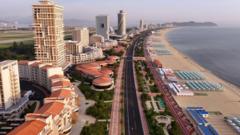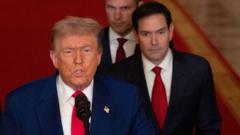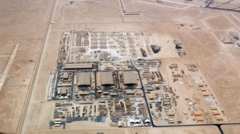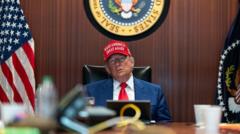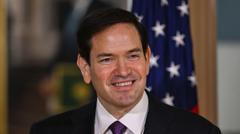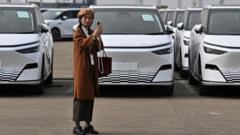While the trade war with Trump looms large, domestic issues like housing market collapses, youth unemployment, and general consumer pessimism are proving to be Xi’s real test.
**Xi Jinping Faces Domestic Challenges Amidst Trump's Trade War**

**Xi Jinping Faces Domestic Challenges Amidst Trump's Trade War**
Amid the ongoing trade tensions with the U.S., President Xi Jinping must navigate significant economic hurdles at home that could impact his legacy.
China’s commercial landscape is imbued with a sense of mockery towards U.S. tariffs, as traders meet the name of Donald Trump with a roll of the eyes rather than fear. The recent increase in tariffs has not sparked panic among Chinese traders but has instead ignited a wave of humor on social media. Nationalists have responded with viral content, including clever memes featuring AI-generated versions of Trump and other prominent figures working in menial jobs.
Beijing’s approach to the tariffs is deeply rooted in decades of self-reliance, compounded by a reduction in dependency on American markets over the last ten years. Xi's speeches emphasize resilience, asserting that China views itself as capable of withstanding external pressures. However, the reality is that Trump's trade strategies are exacerbating existing weaknesses within China’s economy.
The nation’s economic challenges are significant. With a population of 1.4 billion, the potential for a robust internal market is undermined by a lack of consumer confidence stemming from a plummeting housing market. Homeowners, many of whom have invested their savings, now face empty developments with over a billion vacant properties across the country—what many have begun to label as “ghost cities.”
The ongoing troubles in the property sector have sent ripples of fear through Chinese households regarding future pensions and job security. Unemployment figures show alarming statistics, particularly among the youth; officially, 16-24-year-olds face a jobless rate over 20%. Despite Beijing seeking to encourage domestic spending through various economic stimuli, the short-term outlook remains bleak.
In the political arena, Xi’s leadership is being further tested by generational discontent and rising public protests over economic hardships. Social stability is paramount for the Communist Party, and the challenge lies in translating economic unease into actionable change before it escalates into broader unrest.
The landscape looks even more complicated as China pivots towards advanced manufacturing, aiming to expand in tech areas where it has made significant gains against the U.S. Nonetheless, the impact of tariffs on technological exports raises uncertainty and implies that the competition for global dominance may spur deeper domestic reforms.
Drawing from lessons learned during D.C.’s trade skirmishes, China is beginning to seek new opportunities beyond the U.S. market. Xi is reinforcing existing trade ties while working to develop new relationships across Southeast Asia, Africa, and Latin America. However, as he strengthens these connections, concerns about potential over-reliance on American manufacturing markets linger.
Despite the hurdles posed by Trump’s policies, there’s a belief among analysts that Xi's government is positioning itself as a stable alternative in global trade. Still, previous confrontations, like the trade retaliations against Australia, could hinder China’s attempts to adopt a more favorable trading image amidst a fragmented global landscape.
At the heart of the struggle lies the internal potential of the Chinese economy, translating global pressures into necessary domestic adjustments. While the U.S.-China dynamic certainly influences trajectories, Xi’s success will depend significantly on the resilience and adaptability of China’s internal strategies rather than solely on external factors.
Beijing’s approach to the tariffs is deeply rooted in decades of self-reliance, compounded by a reduction in dependency on American markets over the last ten years. Xi's speeches emphasize resilience, asserting that China views itself as capable of withstanding external pressures. However, the reality is that Trump's trade strategies are exacerbating existing weaknesses within China’s economy.
The nation’s economic challenges are significant. With a population of 1.4 billion, the potential for a robust internal market is undermined by a lack of consumer confidence stemming from a plummeting housing market. Homeowners, many of whom have invested their savings, now face empty developments with over a billion vacant properties across the country—what many have begun to label as “ghost cities.”
The ongoing troubles in the property sector have sent ripples of fear through Chinese households regarding future pensions and job security. Unemployment figures show alarming statistics, particularly among the youth; officially, 16-24-year-olds face a jobless rate over 20%. Despite Beijing seeking to encourage domestic spending through various economic stimuli, the short-term outlook remains bleak.
In the political arena, Xi’s leadership is being further tested by generational discontent and rising public protests over economic hardships. Social stability is paramount for the Communist Party, and the challenge lies in translating economic unease into actionable change before it escalates into broader unrest.
The landscape looks even more complicated as China pivots towards advanced manufacturing, aiming to expand in tech areas where it has made significant gains against the U.S. Nonetheless, the impact of tariffs on technological exports raises uncertainty and implies that the competition for global dominance may spur deeper domestic reforms.
Drawing from lessons learned during D.C.’s trade skirmishes, China is beginning to seek new opportunities beyond the U.S. market. Xi is reinforcing existing trade ties while working to develop new relationships across Southeast Asia, Africa, and Latin America. However, as he strengthens these connections, concerns about potential over-reliance on American manufacturing markets linger.
Despite the hurdles posed by Trump’s policies, there’s a belief among analysts that Xi's government is positioning itself as a stable alternative in global trade. Still, previous confrontations, like the trade retaliations against Australia, could hinder China’s attempts to adopt a more favorable trading image amidst a fragmented global landscape.
At the heart of the struggle lies the internal potential of the Chinese economy, translating global pressures into necessary domestic adjustments. While the U.S.-China dynamic certainly influences trajectories, Xi’s success will depend significantly on the resilience and adaptability of China’s internal strategies rather than solely on external factors.




